10 Best Website Feedback Tools to Enhance User Experience
- shems sheikh
- May 23
- 21 min read
Level Up Your Website with Powerful Feedback
Want to create a website that truly resonates with your users? This listicle provides ten powerful website feedback tools to help you gather valuable insights and improve user experience. These tools solve the critical challenge of understanding how visitors interact with your website and identify pain points. Product managers, UX/UI designers, web developers, marketing teams, and remote teams alike will discover effective solutions for collecting user feedback, ranging from visual feedback and heatmaps to targeted surveys. Learn about leading website feedback tools like Hotjar, UserTesting, and Qualaroo, among others, and choose the best fit for your needs.
1. Beep
Streamlining feedback and collaboration on web projects is crucial for any team aiming to deliver high-quality results efficiently. Beep positions itself as a game-changer in this arena, offering a platform designed to transform how teams review and execute web projects with enhanced speed and clarity. Instead of relying on lengthy email chains, confusing screenshots, or time-consuming video calls, Beep allows users to provide contextual feedback directly on live web pages. This visual feedback, coupled with automatically captured screenshots, minimizes ambiguity and makes it incredibly clear what needs to be addressed. This focus on visual clarity makes it an ideal website feedback tool for dispersed or remote teams.
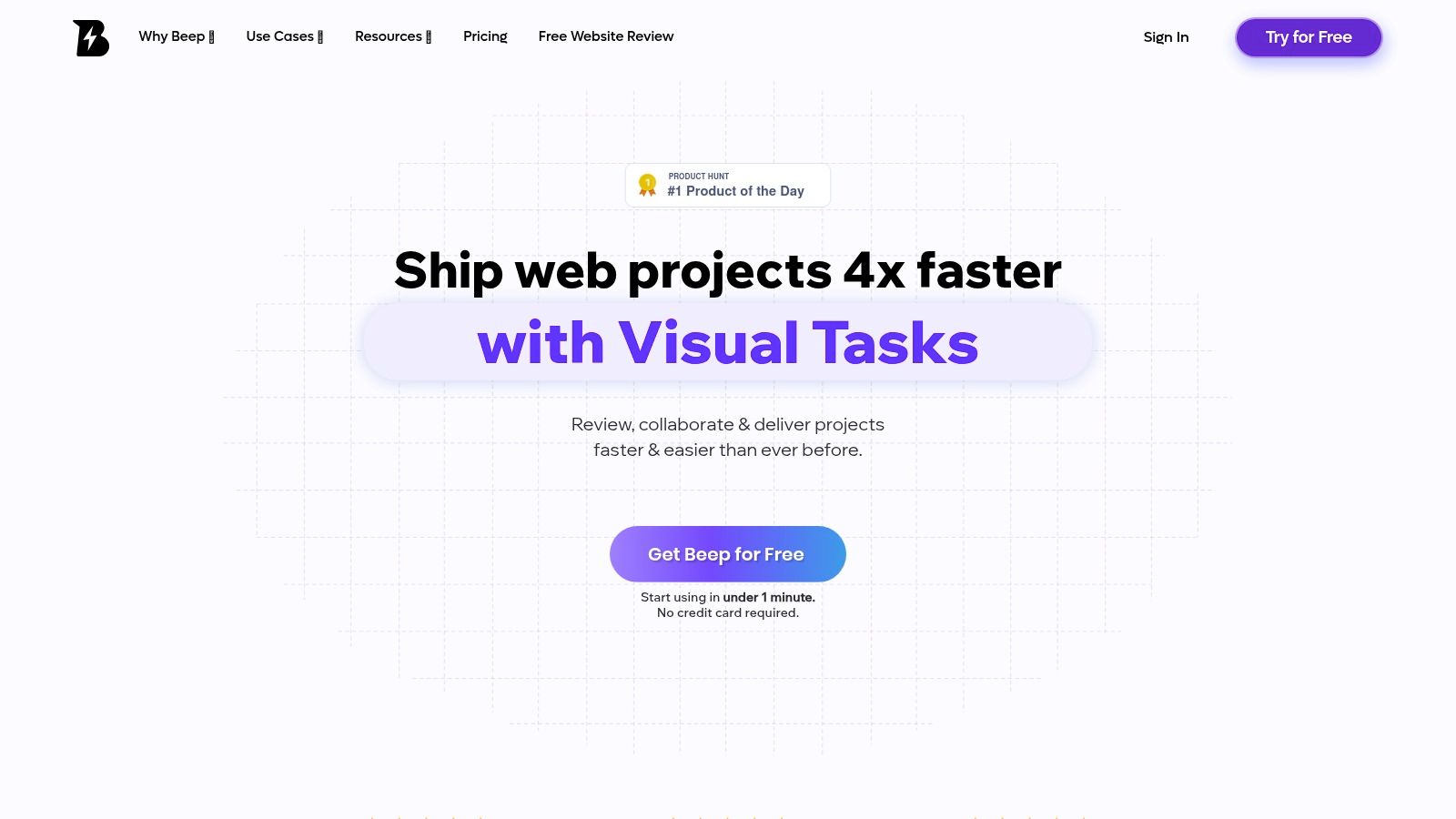
Beep further enhances its workflow by incorporating a built-in Kanban board. This feature enables teams to seamlessly track feedback from initial comment to final implementation, ensuring nothing falls through the cracks. Think of it as a visual to-do list for your website revisions, allowing product managers, designers, and developers to stay aligned on progress and priorities. For example, a UX/UI designer can pinpoint a specific element on a webpage, leave a comment about improving its accessibility, and assign the task directly to a developer. The developer can then mark the task as "in progress" and "completed" as they work through the feedback, providing a transparent and organized workflow.
Seamless integration with popular productivity tools like Slack, Jira, Notion, Zapier, and more makes Beep easily adaptable to your existing workflow. This minimizes disruption while boosting efficiency by centralizing communication and feedback. Imagine receiving a Slack notification when a new feedback item is added to your Kanban board in Beep, or automatically creating a Jira ticket from a specific comment. These integrations empower teams to stay connected and informed without needing to constantly switch between different platforms.
One of Beep's biggest selling points is its ease of use. You can get started in under a minute, without needing a credit card. This low barrier to entry makes it an attractive option for teams of all sizes looking to quickly improve their website feedback process. While Beep's primary focus is on web projects, and may therefore require supplementary tools for non-web projects, its specialized features for website feedback set it apart. While some advanced integrations and features may still be rolling out, the core functionality is robust and offers a compelling solution for teams looking to optimize their web development workflow.
Pros:
Visual feedback with auto-screenshot annotations minimizes ambiguity and enhances clarity.
Built-in Kanban board for straightforward feedback task tracking and progress reporting.
Seamless integrations with leading tools like Slack, Jira, Notion, Zapier, and more.
Drastically reduces time spent on video calls, screenshots, and screen recordings.
Quick setup with no credit card required—start using in less than one minute.
Cons:
Primarily focused on web project feedback; may require complementary tools for non-web projects.
Some advanced integrations and features may still be rolling out, limiting functionalities in early adoption.
Website: https://www.justbeepit.com
2. Hotjar
Hotjar is a powerful, all-in-one website feedback tool that provides valuable insights into user behavior, allowing you to optimize your website for better conversions and user experience. It's a popular choice for product managers, UX/UI designers, web developers, and marketing teams seeking a comprehensive understanding of how users interact with their websites. By combining heatmaps, session recordings, and various feedback mechanisms, Hotjar offers a holistic view of the user journey. This makes it an invaluable asset for identifying pain points, improving usability, and ultimately boosting your website's effectiveness.
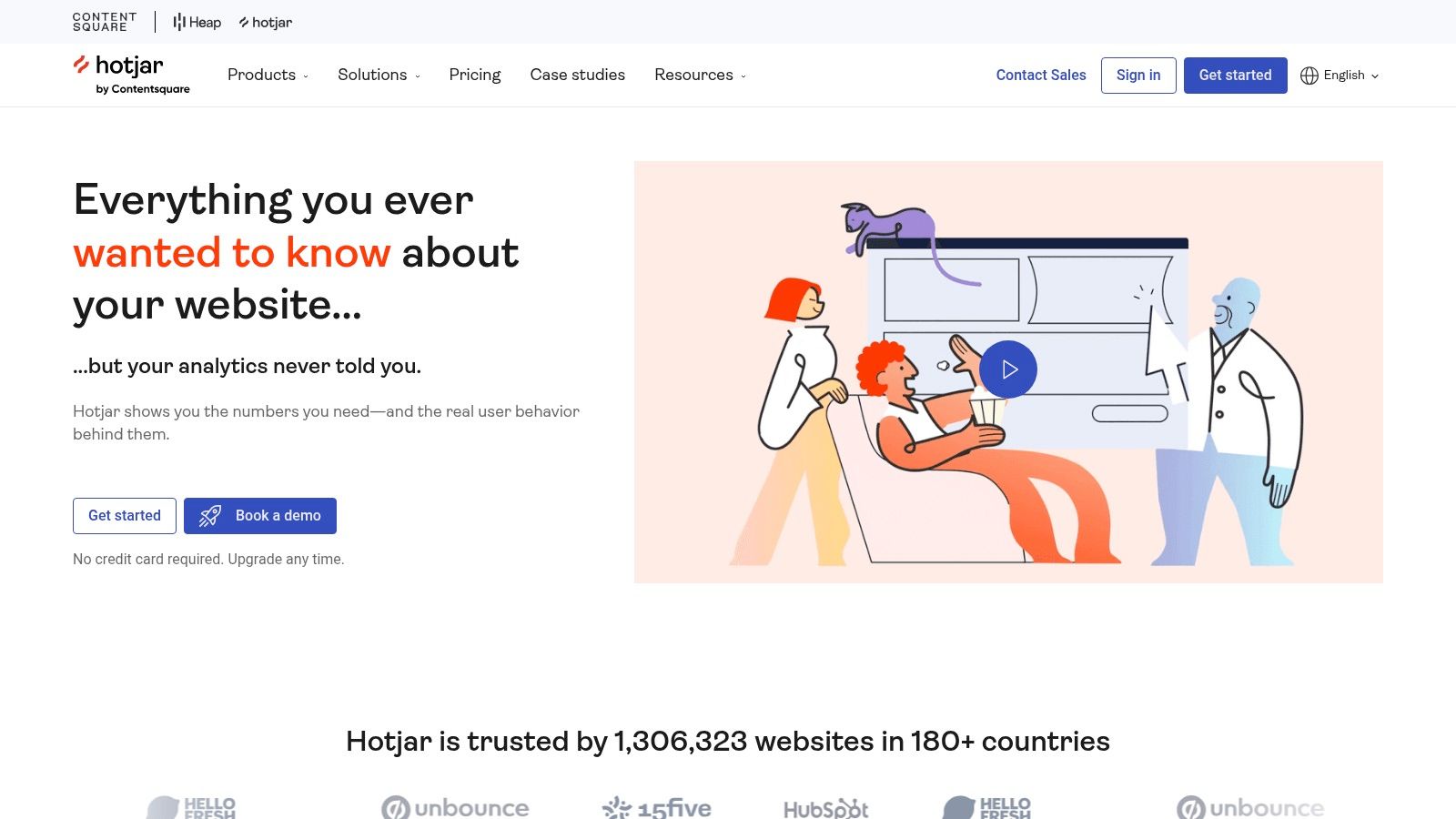
Hotjar's heatmaps visually represent user clicks, taps, and scrolling behavior, highlighting areas of high engagement and those that are being ignored. Session recordings allow you to watch actual user sessions, providing a deeper understanding of how individuals navigate your site and where they encounter difficulties. This feature is incredibly helpful for identifying unexpected user behavior and uncovering usability issues that might be missed by traditional analytics. For direct user feedback, Hotjar offers feedback polls, surveys, and an incoming feedback widget, empowering users to proactively share their thoughts and opinions. Furthermore, Hotjar facilitates user recruitment for research interviews, enabling you to gather in-depth qualitative data directly from your target audience.
Key Features and Benefits:
Heatmaps: Visualize user interaction with your website, identifying popular elements and areas needing improvement.
Session Recordings: Watch real user sessions to understand navigation patterns and identify usability issues.
Feedback Polls and Surveys: Collect targeted user feedback on specific pages or features.
Incoming Feedback Widget: Allow users to easily submit feedback and bug reports directly from your website.
User Recruitment: Streamline the process of recruiting users for usability testing and research interviews.
Pros:
All-in-one platform: Combines analytics and feedback tools for a comprehensive understanding of user behavior.
Visual data presentation: Makes it easy to interpret complex data and identify key insights.
Easy setup: No coding required, allowing for quick implementation.
Free plan available: Suitable for smaller websites and initial testing.
Cons:
Limited customization: Survey and poll customization options are somewhat restricted.
Performance impact: Can potentially affect website performance if not configured optimally.
Pricing: Higher-tier plans can be expensive for smaller businesses.
Pricing: Hotjar offers a free Basic plan for personal use and small websites. Paid plans start at $32/month and offer increased pageview limits, longer recording durations, and more advanced features.
Technical Requirements: Hotjar is a cloud-based service that requires a small tracking code snippet to be added to your website. It's compatible with most popular website platforms and content management systems.
Implementation Tips:
Start with the free plan: Explore the basic features and determine if Hotjar meets your needs before upgrading.
Strategically place feedback widgets: Consider user context and place widgets where they are most relevant.
Regularly review recordings and heatmaps: Identify patterns and trends to inform website optimization efforts.
Segment your audience: Analyze data by user demographics and behavior for more targeted insights.
Comparison with Similar Tools: While tools like Crazy Egg and Mouseflow offer similar heatmapping and session recording functionalities, Hotjar differentiates itself through its comprehensive suite of feedback tools and user recruitment capabilities.
Hotjar deserves a prominent place on this list of website feedback tools because it offers a holistic and user-friendly approach to understanding user behavior. Visit Hotjar
3. UserTesting
UserTesting is a powerful website feedback tool that goes beyond simple surveys and provides rich qualitative insights into the user experience. Unlike basic feedback forms, UserTesting connects you with a diverse panel of real users who provide video recordings of themselves interacting with your website, app, or other digital product. They verbalize their thoughts and reactions as they navigate, providing invaluable context and understanding of user behavior. This makes it a top choice for businesses seeking in-depth user research and a comprehensive understanding of how users experience their digital properties, making it a valuable addition to any suite of website feedback tools. This platform is particularly useful for identifying usability issues, uncovering unmet user needs, and validating design decisions.
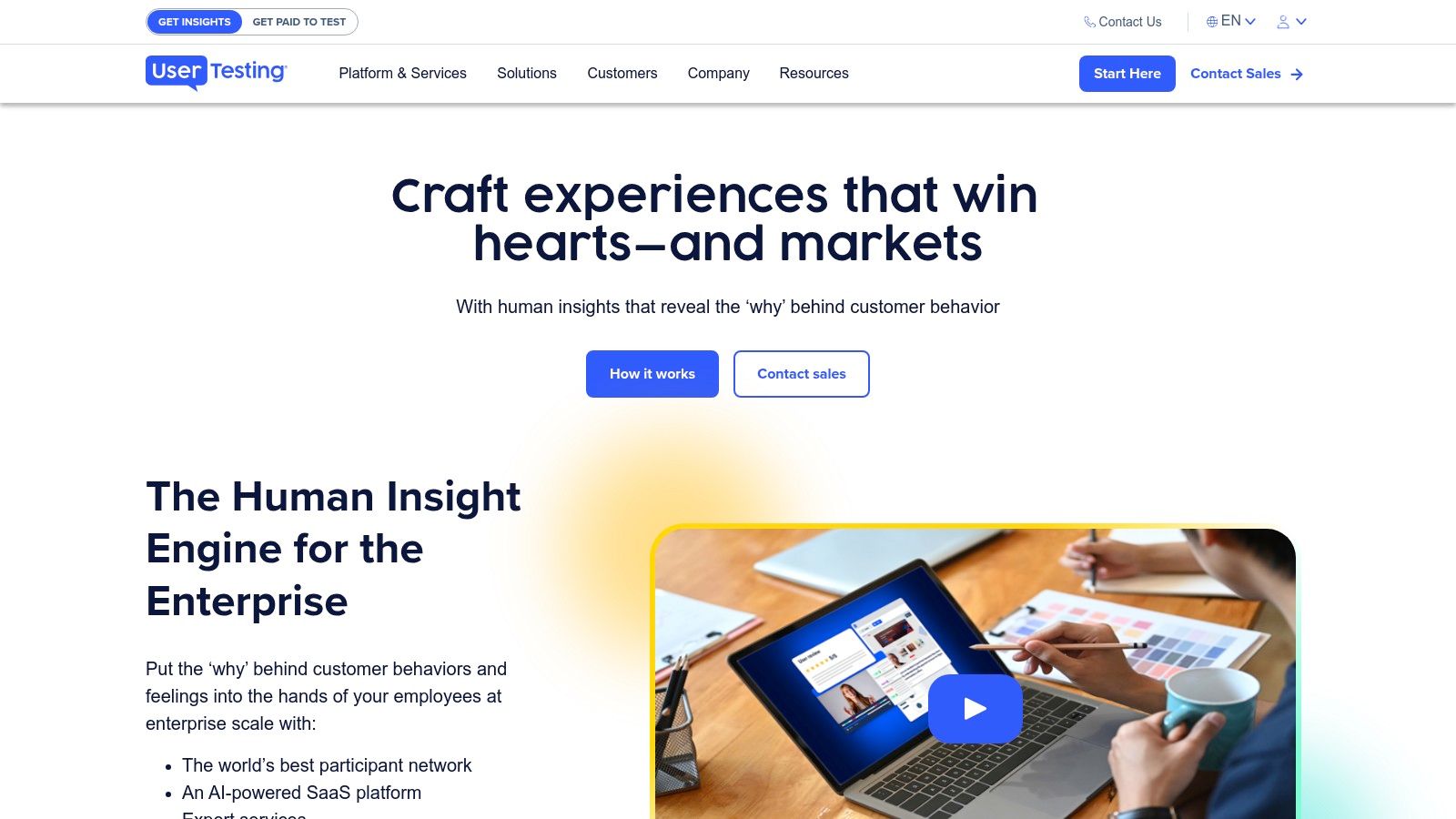
Imagine you're launching a new e-commerce website. With UserTesting, you can observe real users attempting to complete a purchase, identifying any pain points in the checkout process or navigation difficulties. This real-world feedback can then inform crucial design iterations before launch, significantly improving the user experience and potentially boosting conversion rates. For product managers, UX/UI designers, web developers, marketing teams, and even remote teams, this level of detailed user feedback is crucial for making data-driven decisions. Learn more about UserTesting to understand how to maximize your UX insights from their platform.
UserTesting shines through its feature set: on-demand user testing with a diverse panel, video recordings of user sessions, live conversation capabilities, customizable test scenarios and question sets, and powerful reporting tools, including highlight reels. This combination of features provides a robust platform for conducting targeted user research and gathering actionable feedback. While specific pricing isn't publicly available, it's important to note that UserTesting is generally more expensive than self-service feedback tools like survey platforms. This investment, however, brings the benefit of highly detailed, qualitative data directly from your target demographic.
Features:
On-demand user testing with a diverse panel of participants
Video recordings of users completing tasks on your website
Live conversation capability for real-time feedback
Customizable test scenarios and question sets
Highlight reels and insight reporting tools
Pros:
High-quality, detailed feedback from real users
Fast turnaround times for test results
Supports testing across multiple devices and platforms
Advanced targeting options for specific user demographics
Cons:
Significantly more expensive than self-service tools
May require careful test design to get actionable insights
Learning curve for creating effective test scenarios
Website: https://www.usertesting.com/
While UserTesting doesn't list specific technical requirements, a stable internet connection is necessary to stream the video recordings and participate in live conversations. Compared to simpler website feedback tools, UserTesting demands more upfront planning and thoughtful test design. However, for those seeking profound insights into user behavior and a robust understanding of their website's strengths and weaknesses, UserTesting is a worthwhile investment in optimizing the user experience and achieving business goals.
4. Usabilla
Usabilla, now part of SurveyMonkey's GetFeedback platform, is a powerful website feedback tool designed for businesses seeking comprehensive user insights. If you're looking to gather, analyze, and act on user feedback across your digital channels, Usabilla deserves serious consideration among your website feedback tools options. It empowers you to understand user behavior and improve the user experience by capturing feedback in context. This makes it an excellent choice for product managers, UX/UI designers, web developers, marketing teams, and remote teams aiming to optimize their online presence.
One of Usabilla's core strengths lies in its highly customizable feedback collection methods. Unlike some simpler website feedback tools, Usabilla offers customizable feedback buttons and forms that can be seamlessly embedded on your website. This allows you to solicit user opinions at specific touchpoints in the user journey. For example, you can trigger a feedback form after a user completes a purchase, abandons their cart, or interacts with a specific feature. This targeted approach provides valuable contextual feedback, enabling you to identify pain points and areas for improvement.
Beyond basic feedback forms, Usabilla offers advanced features like targeted surveys based on user behavior and a visual feedback tool that allows users to highlight specific elements on the page and provide direct feedback. This is particularly useful for UX/UI designers seeking to understand how users interact with the interface. Imagine a user struggling with a complex form; with the visual feedback tool, they can pinpoint the exact fields causing confusion, providing invaluable insights for the design team.
Usabilla's real-time analytics dashboard provides a centralized hub to monitor and analyze incoming feedback. The platform’s robust targeting options and data visualization and reporting features allow you to segment feedback by user demographics, behavior, and other criteria, enabling you to identify trends and patterns. Furthermore, integrations with popular analytics and CRM tools like Google Analytics and Salesforce allow you to connect user feedback with other data sources for a holistic view of the customer experience.
While Usabilla offers powerful enterprise-grade capabilities, its premium pricing may be prohibitive for smaller businesses. There is no free plan available, and implementing advanced features can require technical resources. If your budget is limited or you lack in-house technical expertise, you might consider exploring alternative website feedback tools like Hotjar or UserReport, which offer free plans and simpler implementation options. However, for larger organizations with dedicated resources and a need for robust feedback collection and analysis, Usabilla’s comprehensive feature set makes it a worthwhile investment.
Implementation Tips:
Plan your feedback strategy: Before implementing Usabilla, define your goals and identify key touchpoints where you want to collect feedback.
Customize feedback forms carefully: Tailor the questions to elicit specific information relevant to your goals.
Utilize targeting options: Segment your audience to gather more relevant feedback.
Integrate with other tools: Connect Usabilla with your analytics and CRM platforms to gain a holistic view of the customer experience.
Key Features:
Customizable feedback buttons and forms
Targeted surveys based on user behavior
Visual feedback tool for highlighting specific elements
Real-time analytics dashboard
Integration with popular analytics and CRM tools
Pros:
Highly customizable feedback collection methods
Enterprise-grade capabilities for large organizations
Robust targeting options for contextual feedback
Strong data visualization and reporting features
Cons:
Premium pricing may be prohibitive for smaller businesses
Can require technical resources for advanced implementations
No free plan available
5. Usersnap
Usersnap is a powerful visual feedback and bug reporting tool specifically designed for website and web application development. It empowers users to capture screenshots directly within their browser, annotate them with detailed comments, and submit this rich feedback directly to your team. This streamlined approach makes Usersnap especially beneficial for development and QA teams, simplifying the process of identifying and resolving bugs during website development and testing. Product managers, UX/UI designers, and even marketing teams can leverage Usersnap to gather targeted feedback on specific features or design elements, promoting a more collaborative and efficient development process. Remote teams also benefit from the centralized nature of the platform, allowing feedback to be collected asynchronously and efficiently regardless of location.

One of Usersnap's key strengths lies in its ability to capture comprehensive technical metadata along with visual feedback. This includes browser information, console logs, and other relevant technical details that are crucial for developers when troubleshooting issues. Features like screenshot annotation, visual feedback collection, and in-browser console log capture significantly reduce the time and effort required to reproduce and fix bugs. Learn more about Usersnap for detailed tips on effective screenshot annotation. This focus on technical detail makes Usersnap a strong choice for teams prioritizing robust bug tracking and resolution. Furthermore, integrations with popular project management tools like JIRA, Trello, and GitHub ensure seamless incorporation into existing development workflows. Customizable feedback widgets allow teams to tailor the appearance and functionality of the tool to their specific needs, enhancing user experience and encouraging more comprehensive feedback.
While Usersnap excels at technical feedback collection, it's worth noting that its focus is less on general UX insights compared to dedicated UX research platforms. Non-technical users might find the platform's extensive technical features overwhelming. Also, while Usersnap allows for feedback organization with custom categories and statuses, its analytics capabilities are more limited compared to tools specifically designed for UX analysis.
Implementing Usersnap is straightforward, generally involving installing a JavaScript snippet on your website. Pricing information is available on the Usersnap website, offering different tiers to cater to various team sizes and project requirements. If your team requires a powerful, technically focused website feedback tool that seamlessly integrates with development workflows, Usersnap deserves serious consideration among other website feedback tools available. For teams prioritizing a balance of visual feedback and in-depth technical details, Usersnap holds a strong position in the market, streamlining communication and accelerating bug resolution within development cycles. It's particularly valuable for website feedback tools seekers prioritizing bug reporting and technical feedback, allowing for efficient communication between testers, developers, and product managers. The platform's strengths lie in its comprehensive metadata capture and integrations with development tools, facilitating rapid troubleshooting and efficient bug resolution.
6. Crazy Egg
Crazy Egg is a powerful website optimization and user behavior analysis tool that earns its place among the best website feedback tools thanks to its intuitive visual reports and versatile features. While its primary focus is on analytics, its feedback collection capabilities make it a valuable asset for understanding not just how users interact with your website, but also why. This is crucial for product managers, UX/UI designers, web developers, and marketing teams seeking to improve website performance and user experience. Crazy Egg helps bridge the gap between raw analytics and actionable insights, allowing teams, including remote ones, to collaborate effectively on data-driven website improvements.
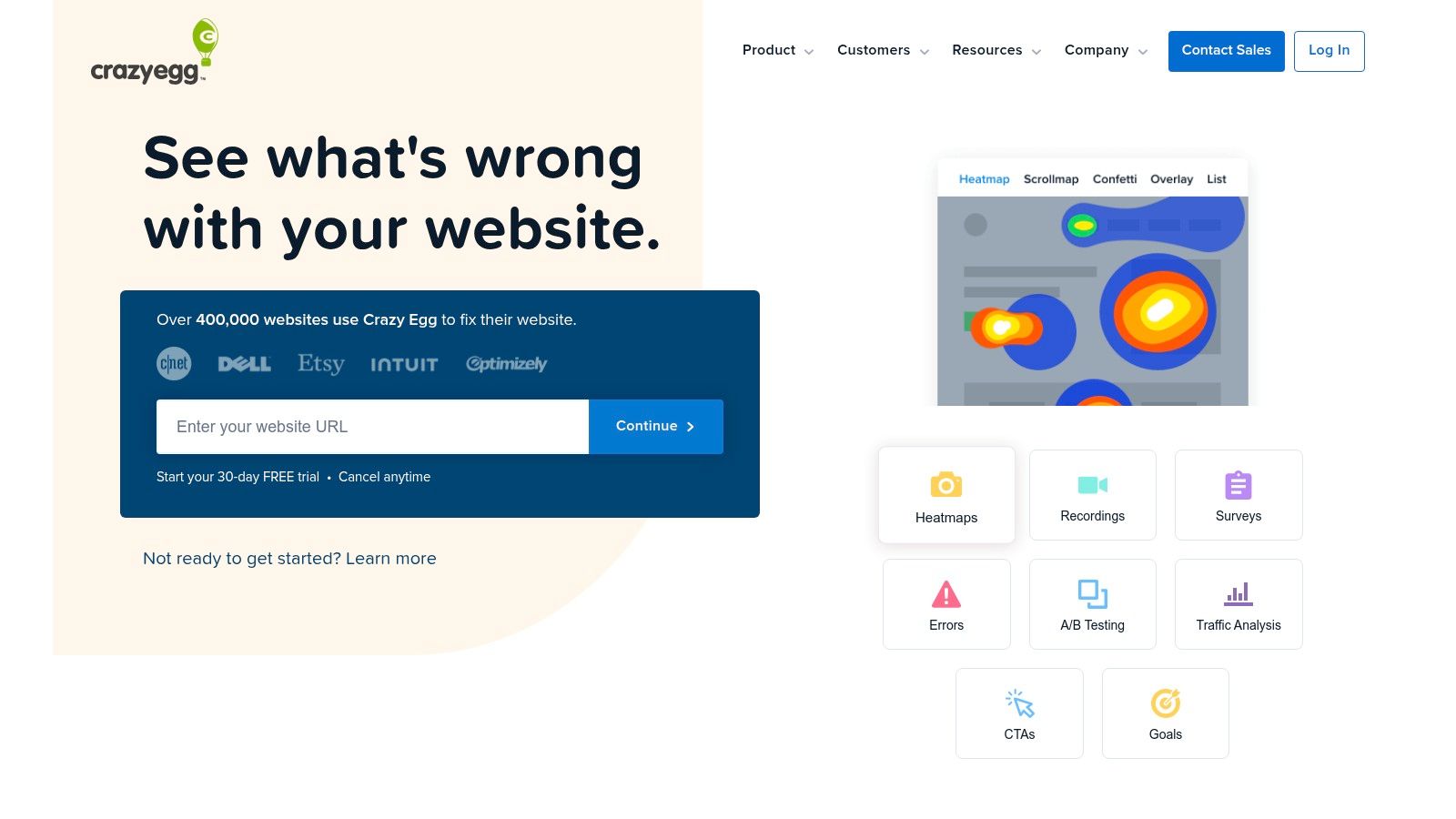
Crazy Egg's core strength lies in its easy-to-understand visual reports. Heatmaps provide a clear picture of where users are clicking and interacting on your pages, highlighting popular elements and potential areas for improvement. Scrollmaps reveal how far down the page users scroll, helping you determine the optimal placement of content and calls to action. For a deeper dive into user behavior, session recordings allow you to observe real user journeys, identifying pain points and areas of friction. These insights are invaluable for UX/UI designers seeking to optimize website navigation and flow. Furthermore, Crazy Egg offers on-page surveys, allowing you to gather direct feedback from users. This is particularly useful for marketing teams looking to understand user preferences and tailor content accordingly.
Crazy Egg seamlessly integrates with popular website platforms, simplifying the setup process. Its pricing is also considerably more affordable compared to enterprise-level analytics solutions, making it accessible to smaller businesses and startups. Importantly, Crazy Egg has minimal impact on website loading speed, ensuring a smooth user experience.
While Crazy Egg boasts a comprehensive suite of features, its feedback tools are less advanced than those offered by dedicated feedback platforms like UserTesting or Qualaroo. Customization options for survey appearance are somewhat limited, and the reporting features, while intuitive, could be more robust. For example, more granular filtering and segmentation options would enhance the analysis of collected feedback data.
Key Features:
Heatmaps: Visualize user clicks and interactions.
Scrollmaps: Track how far users scroll down pages.
A/B Testing: Compare different design versions.
Session Recordings: Observe real user journeys.
On-page Surveys: Collect direct user feedback.
Pros:
Intuitive visual reports
Seamless website integration
Affordable pricing
Minimal impact on website loading speed
Cons:
Basic feedback tools compared to dedicated platforms
Limited survey customization
Reporting could be more robust
Website: https://www.crazyegg.com/
Implementation Tip: Start by identifying key pages you want to analyze. Install the Crazy Egg tracking code on these pages and define your goals. For instance, you might want to track clicks on specific call-to-action buttons or understand scrolling behavior on a landing page. Regularly review the generated reports to identify areas for improvement and A/B test different variations to optimize website performance. Using Crazy Egg in conjunction with other dedicated feedback tools can provide a more holistic view of user behavior.
7. Qualaroo
Qualaroo is a powerful website feedback tool specializing in targeted micro-surveys, making it an excellent choice for businesses seeking granular insights into user behavior and preferences. Unlike generic survey platforms, Qualaroo focuses on gathering contextual feedback at specific points in the user journey, helping you understand why users behave the way they do on your website. This targeted approach allows for more relevant questioning and more actionable feedback, which is invaluable for product development, UX optimization, and marketing strategies. Its capabilities are particularly well-suited for product managers, UX/UI designers, web developers, marketing teams, and even remote teams seeking user feedback. This targeted approach makes it a deserving entry in our list of top website feedback tools.
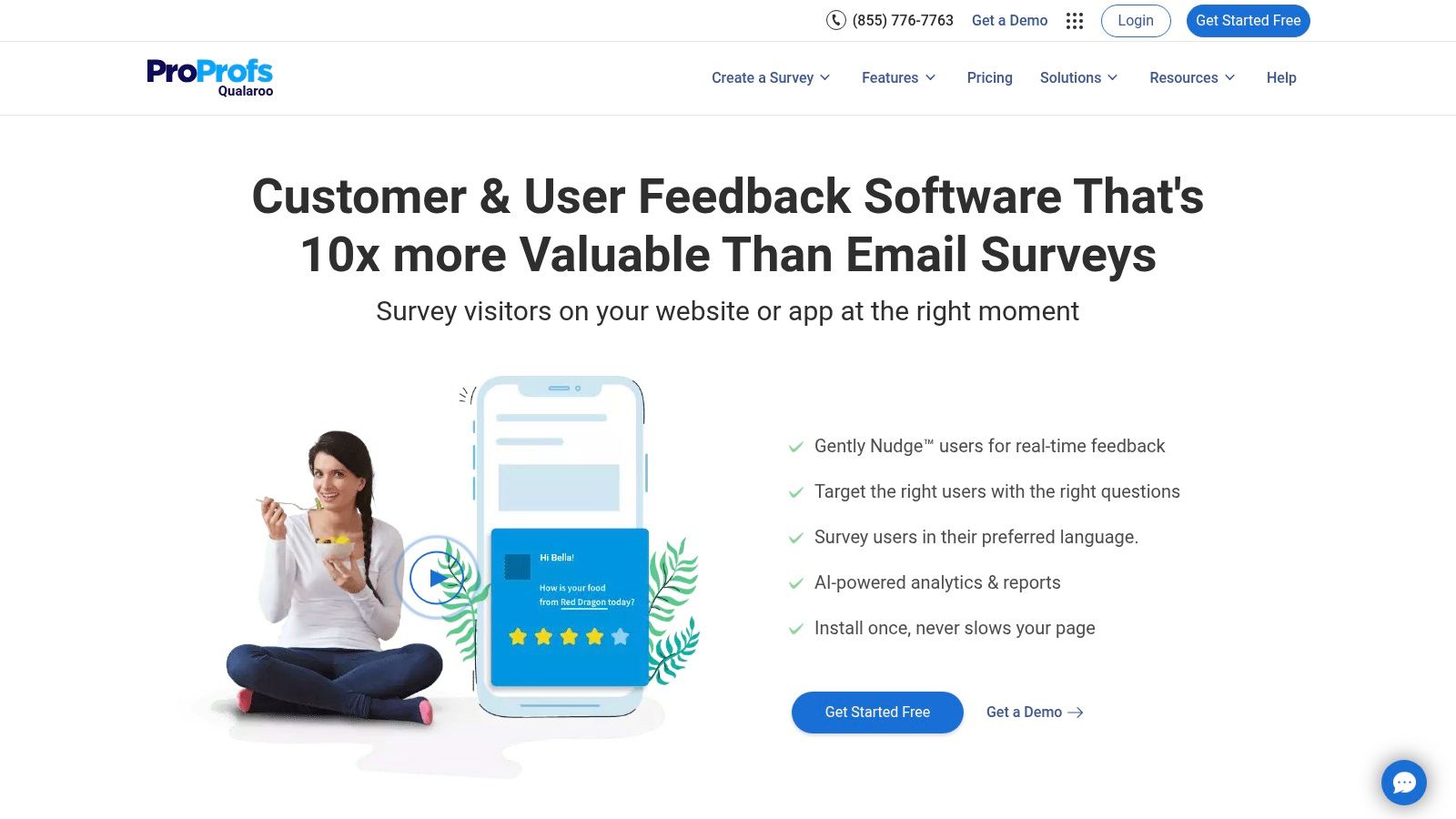
For example, imagine you've launched a new feature on your SaaS product's landing page. With Qualaroo, you could trigger a micro-survey to appear specifically for users who interact with that feature, asking them about their experience. This allows you to gather immediate feedback on the feature's usability and effectiveness without interrupting the experience of other users. You can segment users based on their behavior (e.g., users who abandoned their cart) or attributes (e.g., new users vs. returning users) to ask hyper-relevant questions. This level of targeting distinguishes Qualaroo from broader website feedback tools and provides deep insights into specific user segments.
Qualaroo's features include targeted micro-surveys based on user behavior and attributes, sentiment analysis for open-ended responses, skip logic and branching for personalized survey paths, and NPS (Net Promoter Score) surveys with comprehensive analytics. The integration with analytics platforms and CRM systems allows you to seamlessly incorporate feedback data into your existing workflows. The AI-powered sentiment analysis is a particularly helpful feature for quickly gauging the overall sentiment expressed in open-ended responses, providing valuable qualitative data alongside quantitative metrics.
While Qualaroo offers advanced targeting and sophisticated branching logic, these features can contribute to a more complex setup process, especially for those unfamiliar with such tools. It's important to invest time in understanding the platform's capabilities to maximize its effectiveness. The platform also has a higher price point than basic survey tools, which is a factor to consider depending on your budget and needs. Finally, while the survey design is intentionally unobtrusive to minimize impact on UX, customization options for the visual aspects of the surveys are somewhat limited.
Pros:
Highly targeted survey deployment capabilities
Sophisticated branching logic for personalized questioning
Minimal impact on user experience due to unobtrusive design
AI-powered sentiment analysis for qualitative feedback
Cons:
Higher price point compared to basic survey tools
Complex setup process for advanced targeting scenarios
Limited visual customization options
Website: https://qualaroo.com/
For implementation, begin by clearly defining your research goals and identifying the specific user segments you want to target. Take advantage of Qualaroo's robust targeting options to ensure your surveys reach the right users at the optimal point in their journey. Utilize the branching logic to personalize the survey path based on user responses, creating a more engaging and insightful experience. While pricing information isn't publicly listed, Qualaroo offers customized plans based on your specific needs. Contact their sales team for detailed pricing information and to discuss which plan best aligns with your requirements. Compared to simpler tools like SurveyMonkey or Typeform, Qualaroo offers more advanced targeting and branching logic, making it a superior choice for capturing contextual website feedback.
8. Feedier
Feedier distinguishes itself among website feedback tools by focusing on boosting response rates through gamification and an engaging user experience. Instead of relying on dry, traditional surveys, Feedier uses interactive forms and rewards to incentivize participation. This makes it a powerful tool for businesses looking to gather a substantial amount of feedback data to improve their websites, products, and overall customer experience. It's particularly well-suited for gathering customer satisfaction (CSAT) scores, understanding customer effort scores (CES), and collecting product feedback. For teams struggling with low survey completion rates, Feedier offers a refreshing alternative.
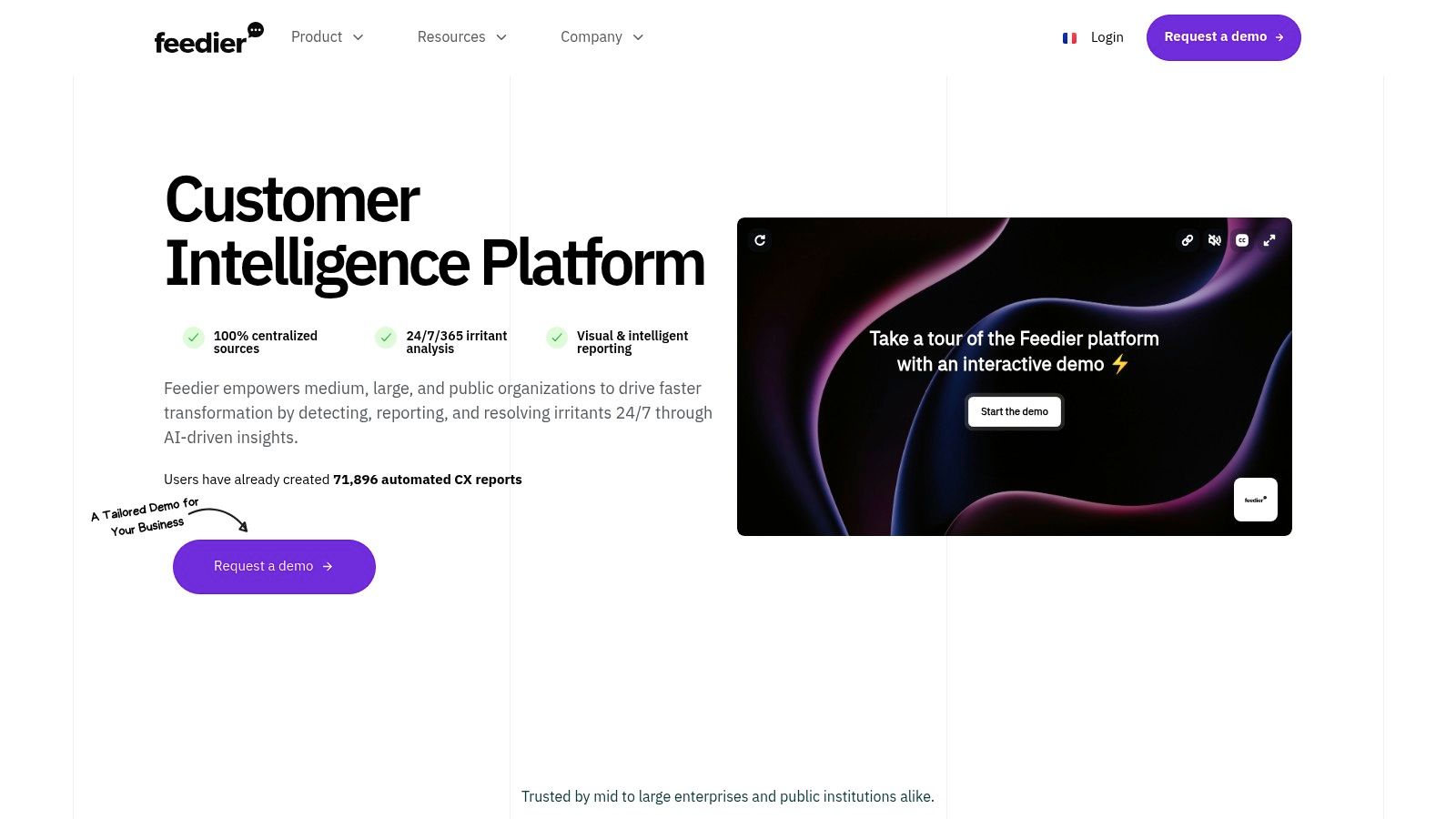
Feedier offers a comprehensive suite of features, including gamified feedback collection with rewards and incentives like coupons, gift cards, or raffle entries. This encourages users to complete the feedback process. Its interactive and visually engaging feedback forms make the experience more enjoyable for users, leading to higher completion rates and more detailed feedback. Multi-channel feedback collection (web, email, QR codes) provides flexibility in how you reach your target audience. Advanced analytics and sentiment analysis tools provide valuable insights into the feedback collected, allowing you to identify trends and areas for improvement. Finally, the platform includes feedback loop management with action tracking, so you can assign tasks, track progress, and close the loop with respondents.
Practical Applications & Use Cases:
E-commerce: Collect product feedback, understand purchase motivations, and identify areas for website improvement to increase conversion rates.
SaaS companies: Gather feedback on new features, identify usability issues, and improve customer onboarding processes.
Market research: Conduct engaging surveys and collect valuable insights into target audiences.
Customer support: Gauge customer satisfaction with support interactions and identify areas for improvement.
Remote teams: Collect feedback from distributed team members on company culture, processes, and tools.
Comparison with Similar Tools:
While tools like Typeform and SurveyMonkey offer interactive elements, Feedier's unique selling proposition is its focus on gamification and rewards. This makes it a particularly effective tool for increasing response rates, especially in situations where traditional surveys struggle.
Implementation/Setup Tips:
Clearly define your goals and target audience before creating a feedback campaign.
Experiment with different reward types to find what resonates most with your audience.
Keep the feedback forms concise and focused to avoid survey fatigue.
Utilize the multi-channel distribution options to reach your target audience effectively.
Regularly analyze the feedback data and take action based on the insights.
Pros:
Higher response rates through gamification elements.
Modern, visually appealing interface for both users and administrators.
Comprehensive feedback management workflow.
Flexible deployment options across multiple channels.
Cons:
Learning curve for setting up gamified feedback campaigns.
Some advanced features are only available on higher-tier plans.
May not be suitable for more formal corporate environments.
Pricing: Feedier offers a free trial and various paid plans based on the number of responses and features required. Check their website for the most up-to-date pricing information.
Technical Requirements: Feedier is a cloud-based platform, so there are no specific technical requirements other than a web browser and internet connection.
Website: https://feedier.com/
Feedier earns its place on this list of website feedback tools because it addresses a common challenge – low response rates – with a creative and engaging solution. Its focus on gamification and user experience sets it apart, making it a valuable tool for businesses seeking to gather rich and actionable feedback data.
9. SurveyMonkey
SurveyMonkey is a powerful and versatile survey platform suitable for a wide range of data collection needs, including website feedback. While not solely a website feedback tool, its robust features and extensive customization options make it a viable option for gathering user opinions and insights. It allows you to create everything from simple polls to complex questionnaires, enabling you to collect detailed feedback on specific aspects of your website, such as user experience, design, content, or even specific product pages. This versatility is a key reason for its inclusion in this list of top website feedback tools.
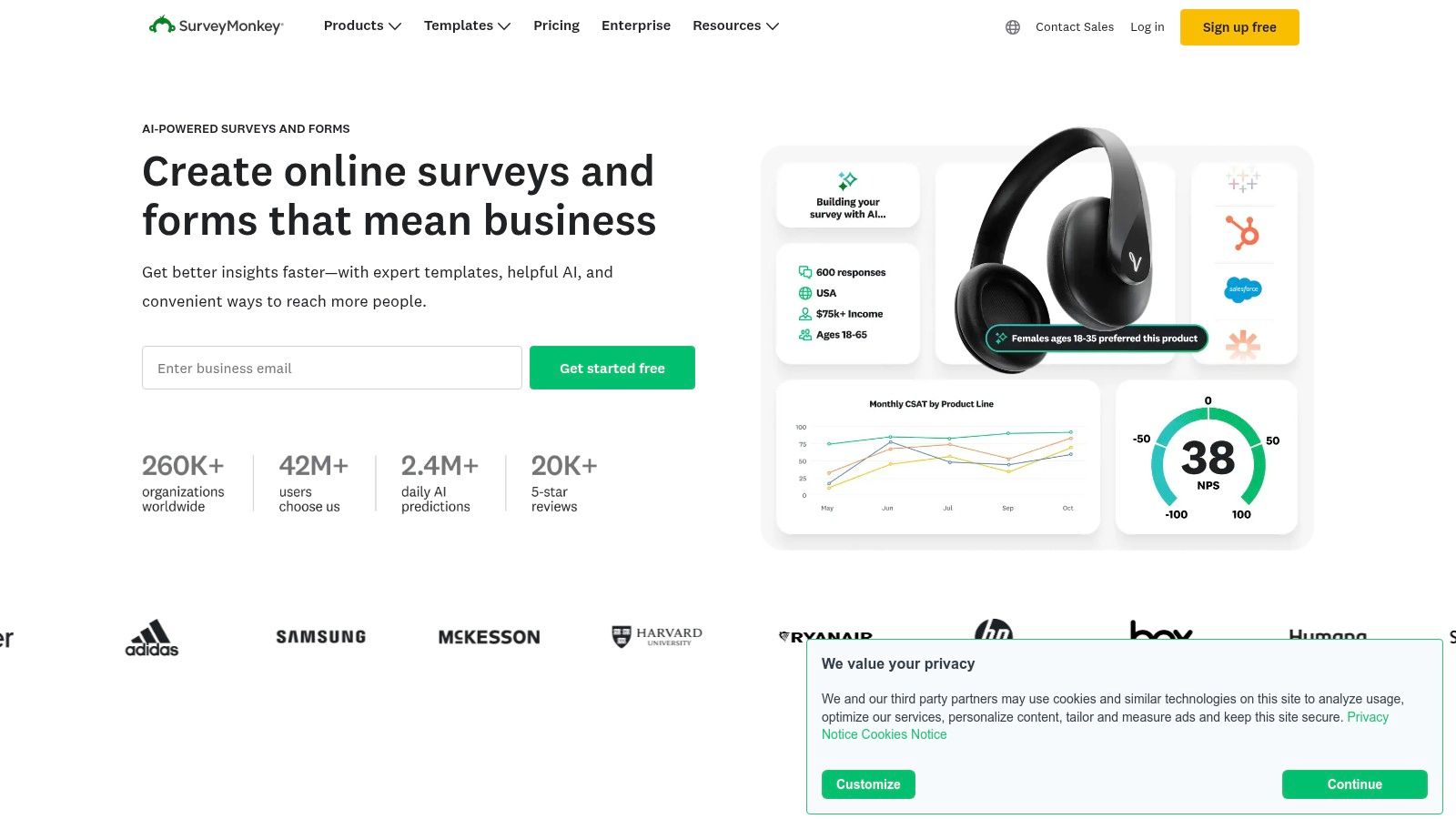
For product managers, UX/UI designers, and web developers, SurveyMonkey offers a practical way to gather data for user research, usability testing, and A/B testing. Marketing teams can leverage the platform to understand customer preferences and tailor website content accordingly. Even remote teams can benefit from its collaborative features to build and analyze surveys together.
SurveyMonkey offers various question types, from multiple choice and rating scales to open-ended text fields, enabling you to capture a wide range of feedback. Its logic features allow you to tailor the survey flow based on user responses, creating a more personalized and engaging experience. You can embed surveys directly onto your website using pop-ups or dedicated links, making it easy for visitors to provide feedback. While the integration might not be as seamless as dedicated website feedback tools, SurveyMonkey compensates with its comprehensive analytics and reporting features, providing valuable insights into user behavior and preferences.
Features:
Extensive library of customizable survey templates
Multiple question types and survey logic options
Comprehensive analytics and reporting tools
Website embedding capabilities for on-site feedback
Integration with hundreds of apps and platforms
Pros:
Extremely versatile with options for almost any survey need
Intuitive survey builder with drag-and-drop functionality
Robust data analysis and visualization tools
Widely recognized and trusted by respondents
Cons:
Not specifically designed for website feedback collection
Free plan has significant limitations
Less seamless website integration compared to dedicated feedback tools
While pricing details can vary, SurveyMonkey offers different plans to cater to various needs, from individual users to large enterprises. You can Learn more about SurveyMonkey and explore different pricing tiers on their website.
Implementation Tips:
Define your goals: Before creating your survey, clearly outline the information you want to gather. This will help you choose the right question types and structure your survey effectively.
Use pre-built templates: Leverage SurveyMonkey's extensive library of templates to save time and ensure best practices.
Test your survey: Before launching your survey, test it thoroughly to identify any issues with logic, flow, or question clarity.
Promote your survey: Encourage website visitors to participate by prominently displaying your survey link or using pop-ups strategically.
Analyze your results: Use SurveyMonkey's powerful analytics tools to understand user feedback and identify areas for website improvement.
Although other tools like Hotjar or Qualaroo offer more specialized website feedback features, SurveyMonkey's versatility and robust feature set make it a worthwhile consideration for those seeking a comprehensive survey solution that can also address website feedback needs. Its ease of use, powerful analytics, and extensive customization options make it a valuable asset for anyone looking to gather user insights and improve their website. You can explore their website for further details: https://www.surveymonkey.com/.
10. Mopinion
Mopinion is a powerful, enterprise-grade feedback analytics platform built specifically for gathering and analyzing user feedback across digital channels. This makes it an excellent website feedback tool for larger organizations and enterprises with complex needs and a high volume of feedback data. If you need granular control, advanced analytics, and seamless integration with your existing workflows, Mopinion is worth considering. It enables businesses to collect actionable insights from websites, mobile apps, and even email campaigns, providing a holistic view of the customer experience. This focus on a multi-channel approach makes Mopinion a valuable tool for understanding customer journeys across different touchpoints.
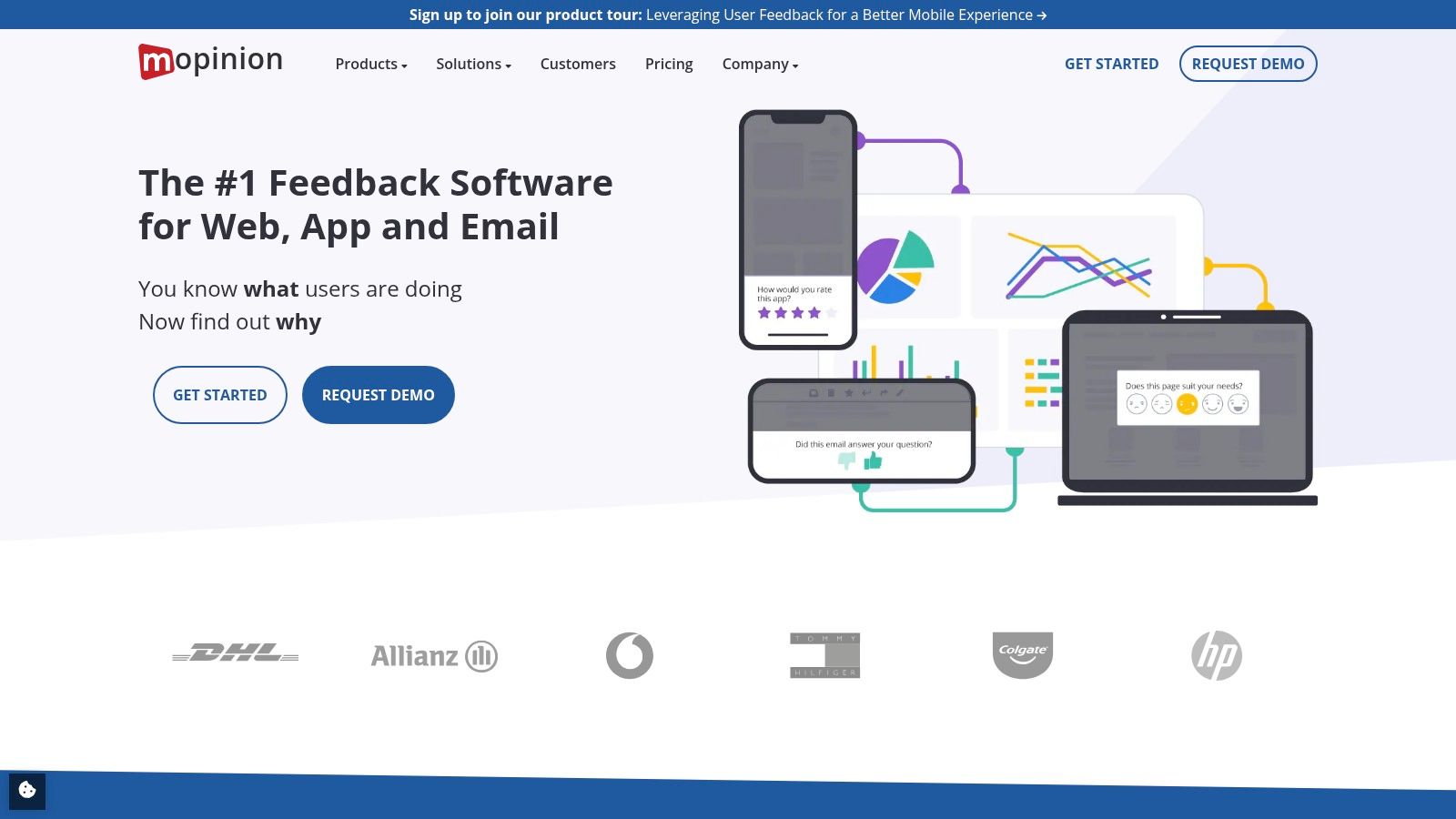
Mopinion shines with its advanced features, including highly customizable feedback forms with conditional logic. This allows you to tailor questions based on previous responses, providing a more personalized and relevant experience for users and gathering more specific data. For example, if a user rates their experience poorly, the form can dynamically present follow-up questions to understand the reasons behind the low rating. Real-time feedback analysis with sophisticated text analytics, including sentiment analysis, helps you quickly identify trends and recurring issues. This is invaluable for product managers and UX/UI designers looking to pinpoint areas for improvement. Customizable dashboards and reporting features allow you to visualize data in a way that makes sense for your specific needs, while the built-in action management system ensures that feedback is addressed and closed the loop, fostering a culture of continuous improvement. Role-based access control facilitates effective team collaboration by allowing you to manage permissions and ensure data security.
For website feedback specifically, Mopinion allows you to implement various feedback forms, including slide-in surveys, pop-ups, and embedded feedback buttons. This flexibility allows you to choose the method that best suits your website's design and user experience. You can target specific pages or user segments with different forms and customize the triggers that activate them. For example, you could target a feedback form about the checkout process specifically to users who have abandoned their carts.
While Mopinion’s robust capabilities make it ideal for enterprise-level organizations, it's important to consider the associated costs. The platform requires a significant investment, particularly for enterprise-level plans, which can be a barrier for smaller businesses or those with limited budgets. Pricing is not readily available on their website and requires contacting their sales team for a tailored quote. The setup process can also be complex, requiring some technical expertise, and the platform has a steeper learning curve compared to more basic website feedback tools. Therefore, while Mopinion is a top-tier solution for complex organizations seeking in-depth feedback analysis, simpler, more cost-effective tools might be a better fit for smaller teams with less demanding needs.
Key Features & Benefits:
Advanced Feedback Forms: Create highly customizable forms with conditional logic and branching for tailored feedback collection.
Real-Time Analysis & Text Analytics: Quickly identify emerging trends and sentiment within feedback data.
Customizable Dashboards & Reporting: Visualize data in a way that's meaningful to your stakeholders.
Action Management System: Close the feedback loop and drive continuous improvement.
Role-Based Access Control: Enhance team collaboration and maintain data security.
Multi-Channel Feedback Collection: Gather feedback from websites, mobile apps, and email campaigns.
Pros:
Enterprise-level capabilities for complex organizations
Powerful text and sentiment analysis features
Comprehensive visualization tools for feedback data
Flexible deployment options for various digital touchpoints
Cons:
Significant investment required for enterprise plans
Complex setup process requiring technical resources
Steeper learning curve compared to simpler feedback tools
Website: https://mopinion.com/
Top 10 Website Feedback Tools Comparison
Platform | Core Features ✨ | User Experience & Quality ★★★★☆ | Value Proposition 💰 | Target Audience 👥 | Unique Selling Points 🏆✨ |
|---|---|---|---|---|---|
Beep 🏆 | Visual feedback with auto-screenshots, Kanban board | ★★★★★ Streamlines feedback with visual clarity | 💰 Quick setup, free start, saves hours weekly | 👥 Web teams, project managers | 🏆 Visual annotation + kanban + seamless integrations |
Hotjar | Heatmaps, session recordings, feedback polls | ★★★★☆ Easy visual insights and setup | 💰 Free plan, higher tiers can be costly | 👥 Marketers, UX researchers | ✨ All-in-one analytics & feedback |
UserTesting | Video feedback from test users, live conversation | ★★★★★ In-depth qualitative insights | 💰 Premium pricing | 👥 UX teams, product managers | ✨ Real user videos + live feedback |
Usabilla | Custom feedback forms, targeted surveys | ★★★★☆ Enterprise-grade customization | 💰 Premium pricing, no free plan | 👥 Large enterprises, CX teams | ✨ Contextual feedback + strong analytics |
Usersnap | Screenshot annotation, bug reporting metadata | ★★★★☆ Great for technical feedback | 💰 Mid-tier pricing | 👥 Dev & QA teams | ✨ Bug reporting + metadata capture |
Crazy Egg | Heatmaps, scrollmaps, A/B testing, session recordings | ★★★★☆ Intuitive reports | 💰 Affordable plans | 👥 Marketers, website owners | ✨ User behavior insights + basic feedback |
Qualaroo | Targeted micro-surveys, sentiment analysis | ★★★★☆ Personalized survey logic | 💰 Higher price point | 👥 UX researchers, marketers | ✨ AI sentiment analysis + advanced targeting |
Feedier | Gamified feedback, multi-channel collection | ★★★★☆ Engaging and interactive | 💰 Flexible pricing, some features premium | 👥 Customer experience teams | ✨ Gamification for higher response rates |
SurveyMonkey | Custom surveys, analytics, embedding | ★★★★☆ Versatile but less focused on web feedback | 💰 Free tier limited, paid for full features | 👥 All business sizes | ✨ Wide survey templates & integrations |
Mopinion | Advanced feedback forms, real-time analytics | ★★★★☆ Enterprise-level analytics | 💰 Enterprise pricing, complex setup | 👥 Large enterprises | ✨ Action management + text analytics |
Choosing the Right Website Feedback Tool
Selecting the perfect website feedback tool from the myriad of options available—from established platforms like SurveyMonkey and Qualaroo to visual feedback tools like Hotjar and Crazy Egg, and in-context solutions such as Usersnap, Usabilla, Feedier, UserTesting, Mopinion, and Beep—can feel overwhelming. The key is to focus on your specific needs. This article has explored ten popular website feedback tools, each with its own strengths and weaknesses. Remember the most important takeaways: identify the type of feedback you're looking for (e.g., bug reports, usability testing, general satisfaction), consider your budget, and assess the technical expertise required for implementation and ongoing management.
Some tools excel at quantitative data collection through surveys (like SurveyMonkey), while others prioritize qualitative insights through heatmaps and session recordings (like Hotjar). Consider whether you need integrations with existing project management or CRM software, and how important features like user segmentation and A/B testing are to your workflow. Even customer service interactions can be enhanced by incorporating website feedback, and increasingly, AI chatbots for customer service are being used to automate and enhance these interactions. To learn more about how AI chatbots are transforming customer support and improving efficiency, check out this helpful article. Choosing the right website feedback tool empowers you to gather targeted user insights, create a better user experience, and ultimately, improve your website's performance.
By carefully evaluating your requirements and matching them with the features offered by different website feedback tools, you can make an informed decision that sets you up for success. For a powerful and streamlined approach to collecting in-context user feedback, check out Beep. Beep allows you to gather targeted feedback directly on your website, empowering you to identify and address usability issues quickly and efficiently.

.png)
Comments